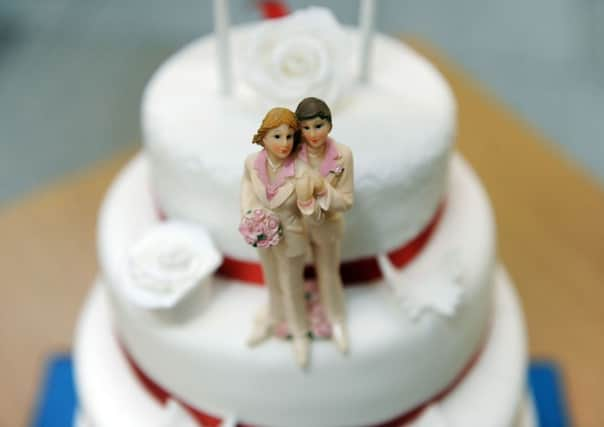Comment: Same-sex marriage: What took us so long?


NEXT Tuesday the Scottish Parliament will hold the final debate and vote on the Marriage and Civil Partnership (Scotland) Bill. If MSPs pass the bill, in what will be a free vote, same-sex marriage will start by early next year. Equal marriage will be the last major step in 45 years’ work for lesbian, gay and bisexual (LGB) equality in the law of Scotland.
From the foundation of Scotland’s first sexual orientation equality organisation, Scottish Minorities Group, in 1969, it took 11 years to decriminalise sex between men, and a further 20 years to achieve an equal age of consent rather than the absurd age of 21 set in 1980. But since 2000, the pace of legal change has picked up. The introduction of civil partnership, adoption and fostering by same-sex couples, laws banning discrimination at work and in sales and services, and laws to address hate crime, have revolutionised the legal framework for LGB people.
Advertisement
Hide AdAdvertisement
Hide AdNow we are on the verge of full equality in the law. Why have these changes happened so quickly?
In the 1960s, lesbian, gay and bisexual people could not be open about their sex life. For men, that could have meant possible imprisonment, and for women, huge discrimination and stigma.
Gay liberation in the 1970s saw some brave LGB people starting to come out of the closet, even in Scotland where sex between men was still a crime. In the 1980s we started to appear on TV, although generally as objects of fascination or controversy, and always to loud complaints and media condemnation.
Even at the end of the 1980s, most people still believed they personally knew no-one who was LGB. And 75 per cent of British people believed homosexuality to be wrong.
But over the past 25 years, as more LGB folk felt able to be open with their friends, family and colleagues, people’s attitudes started to change. That change made it easier for more people to come out, changing attitudes further, and creating a snowball effect. Now, most LGB people are out to their family and friends, and the large majority of Scots have openly LGB friends and family.
The simple fact that most people now know we don’t have two heads, and that we have relationships just like anyone else’s, has underpinned the rise in support for same-sex marriage across Scotland, from 41 per cent in 2002, to 53 per cent in 2006, and 61 per cent by 2010. Most young people in particular can’t understand what all the fuss around same-sex marriage is about.
It was against that background that Scotland’s political parties led the way in the UK in adopting policies on equal marriage. At the 2011 Holyrood election, the SNP and Labour manifestos included pledges to consult publicly on the introduction of same-sex marriage, while the LibDems and Greens promised simply to introduce it. Alex Salmond personally gave his support in TV interviews a few days before the election.
True to their word, the Scottish Government published the UK’s first consultation on equal marriage in September 2011. It has been frustrating for same-sex couples in Scotland to see England and Wales move ahead on this, but the advantage of the lengthy Scottish process is that consultation and discussion can lead to better law. The Scottish proposals were significantly changed as a result of consultation responses, ensuring the freedoms of those with religious objections to same-sex marriage.
Advertisement
Hide AdAdvertisement
Hide AdThe Scottish Parliament’s equal opportunities committee did a great job of taking evidence on the Government’s bill. That committee has a rather larger proportion of same-sex marriage sceptics than the parliament as a whole, and that helped ensure that all sides of the debate were closely examined. The committee produced a detailed report on the evidence, and in a free vote on 20 November, the parliament voted by 98 votes to 15 to approve the principles of the bill.
Since then, the committee has further improved the bill with amendments. The Equality Network hopes that, on Tuesday, MSPs will approve what is now an excellent piece of legislation, which balances equality with freedom of speech, opinion and religion. The equal opportunities committee rejected Stage Two amendments which would have tipped the balance from freedom of speech into discrimination, for example by singling out opposition to same-sex marriage as worthy of special respect in law. We hope that MSPs will similarly reject such amendments at Stage Three.
If the bill passes, Scotland will become the 17th country in the world to legalise same-sex marriage in what will be a historic milestone for LGBT equality and an important step to a fairer society.
But while the vote will mark the end of one long journey – from criminalisation to legal equality for LGB people – there is still a long way to go to secure full equality in the law for transgender people, and much more to do to end the barriers, prejudice and discrimination that LGBT people continue to face. In all of these areas our work must continue.
• Tim Hopkins is director of the Equality Network: equality-network.org